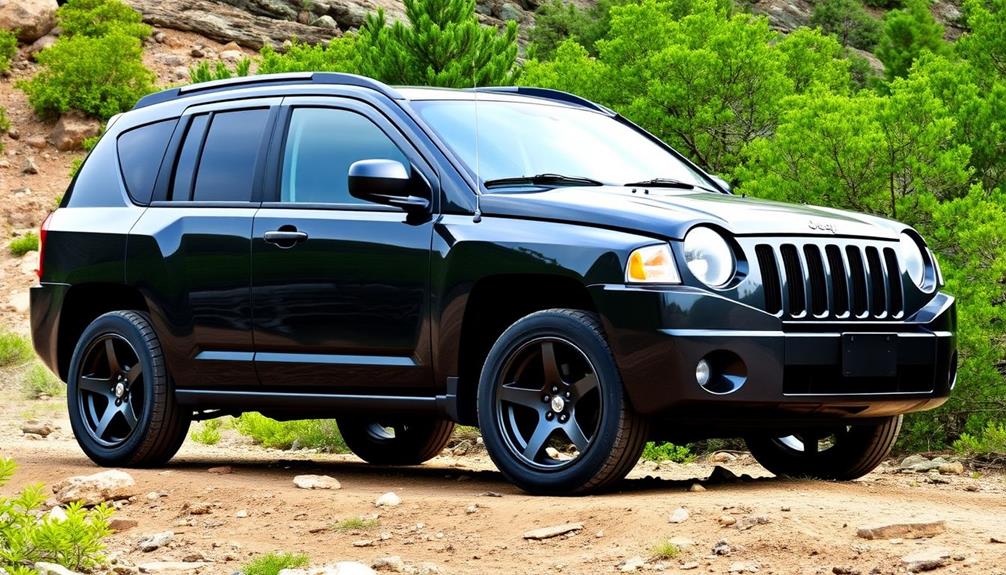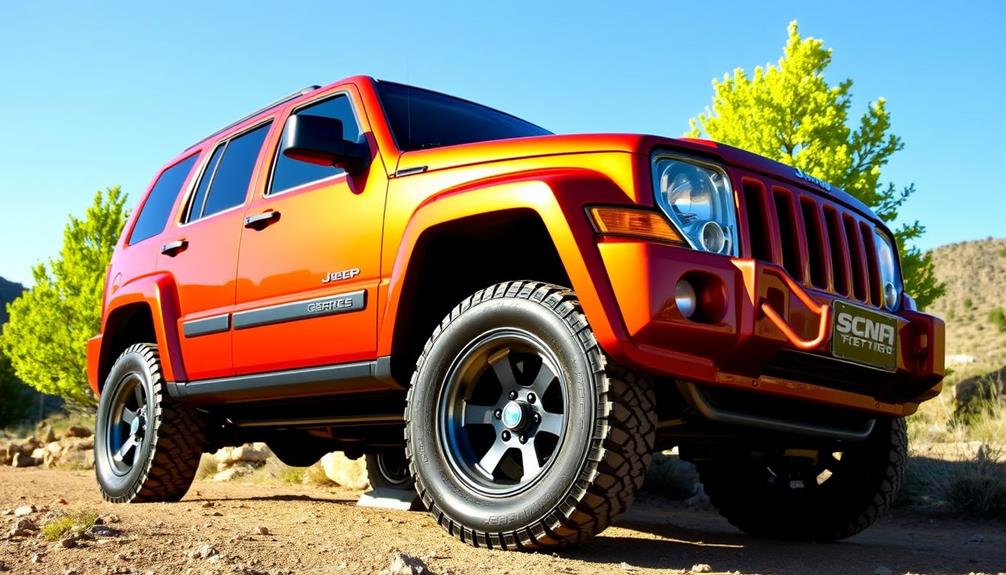Tuning your Jeep Patriot's 4×4 system can considerably elevate its performance and traction, allowing you to access its true potential as an all-wheel drive SUV. By adjusting the Powertrain Control Module, you can improve throttle response and fuel efficiency. Upgrading to high-performance winter tires enhances handling in cold conditions, while regular maintenance keeps the rear drive unit functioning efficiently. Don't overlook the importance of maintaining proper tire condition for improved traction. Discovering more about advanced control features and maintenance tips can further boost your Patriot's capabilities on challenging terrains.
Key Takeaways
- Tuning the Powertrain Control Module (PCM) enhances throttle response and fuel efficiency, optimizing overall engine performance for better 4×4 capabilities.
- Upgrading to high-performance winter or all-terrain tires significantly improves traction and handling, especially in cold or slippery conditions.
- Regular maintenance of the 4×4 system, including fluid checks, ensures longevity and reliability, maximizing your SUV's off-road potential.
- Implementing suspension upgrades enhances stability and cornering performance, allowing for a smoother driving experience on various terrains.
- Manual clutch locking provides a traditional four-wheel drive experience, boosting traction while maintaining control in challenging environments.
Understanding the 4×4 System
When you think of off-roading, the 4×4 system in your Jeep Patriot plays an essential role in tackling rugged terrain. This four-wheel drive system is designed to automatically engage when it detects wheel slip, distributing 20-30% of the power to the rear wheels for improved traction.
This means you can confidently navigate through challenging conditions without worrying about getting stuck.
You can further enhance your traction by using the 4×4 LOCK switch, which achieves a 50/50 power split between the front and rear axles. This is especially useful when you're dealing with slippery surfaces or steep inclines.
The front transaxle operates with an open differential, allowing power to transfer to the wheel with less traction, while the rear differential also functions similarly with an electronic clutch.
Key Mechanical Components

The effectiveness of the Jeep Patriot's 4×4 system relies heavily on its key mechanical components. At the heart of this system is the Power Transfer Unit (PTU), which efficiently distributes power by engaging the rear differential only when it detects front wheel slippage. This design allows for seamless shifts between 2WD and 4WD without driver intervention.
The front transaxle features an open differential, sending power to the wheel with less traction, while the rear differential also operates as an open unit but includes an electronic clutch. This clutch, rated for 1,800 foot-pounds of torque, greatly enhances traction when needed, often exceeding the engine's output capacity.
Regular maintenance of the rear drive unit is essential since it requires more frequent servicing due to potential oil contamination from friction elements.
Additionally, the system automatically disengages above 35 mph to protect the components from damage during high-speed driving. By understanding these key mechanical components, you can appreciate how they work together to release the true potential of your Jeep Patriot's all-wheel drive capabilities.
Performance Factors to Consider

Many factors can impact the performance of your Jeep Patriot's 4×4 system, and understanding them is vital to maximizing its capabilities.
First, consider your tires. Upgrading to high-performance winter tires can considerably enhance traction and handling in slippery conditions. This is especially true when temperatures drop below 40°F. Your tire condition is essential; worn tires with 60% tread or more can lead to reduced traction and handling issues.
Next, pay attention to your rear drive unit. It requires more frequent servicing than traditional differentials, so plan a check at 60,000 miles to avoid any potential oil contamination that could compromise performance.
When maneuvering through snowy or uneven terrain, engage the 4×4 LOCK mode for a 50/50 power split between the front and rear axles, enhancing traction.
Finally, understanding the Jeep Patriot's electronic clutch system is important, as it selectively distributes power to the rear wheels based on traction needs. If the check engine light comes on, don't ignore it; address any underlying issues to maintain ideal performance.
Comparing 4×4 Systems

When you're considering the 4×4 systems available in vehicles like the Jeep Patriot, it's crucial to understand the differences between 4WD and AWD.
The Patriot's unique mechanics set it apart from competitors, offering an adaptive response to traction needs rather than a fixed distribution.
Let's compare how these systems stack up against each other to see which might suit your driving style best.
4WD Vs. AWD Differences
Understanding the differences between 4WD and AWD can considerably influence your driving experience. Four-wheel drive (4WD) systems are typically designed for off-road vehicles, locking the front and rear wheels together to enhance traction on rugged terrains. In contrast, all-wheel drive (AWD) systems, like the one in your Jeep Patriot, allow for independent wheel rotation, making them ideal for varied on-road conditions.
Here's a quick comparison:
| Feature | 4WD | AWD |
|---|---|---|
| Wheel Engagement | Manual or automatic | Automatic |
| Traction Control | Locking capabilities | Independent wheel rotation |
| Best Use | Off-road conditions | On-road, slippery conditions |
| Performance | Better for severe terrains | More effective for everyday driving |
| Typical Vehicles | Off-road trucks/SUVs | Crossovers, sedans, SUVs |
While 4WD excels in extreme off-road scenarios, AWD is generally more effective for daily driving, especially in rain or snow. Understanding these distinctions will help you maximize the performance of your Jeep Patriot in various driving conditions.
Jeep Patriot's Unique Mechanics
The Jeep Patriot showcases a unique 4×4 system that blends innovation with practicality, making it distinct from traditional 4WD setups.
Unlike conventional systems, the Patriot employs a front-wheel-drive based design that automatically engages power to the rear wheels when it detects slippage. Under normal conditions, it distributes 20-30% of power to the rear wheels, guaranteeing you have the traction you need without the hassle of manual controls.
When you activate the 4×4 LOCK switch, the electronic control system provides a 50/50 power split, enhancing your traction in challenging environments. The open differential in the front transaxle allows power to be sent to the wheel with less traction, while the rear differential utilizes an electronic clutch that adjusts based on your traction needs.
You'll notice the system's performance varies in snowy conditions, often mimicking rear-wheel drive behavior until you engage the LOCK mode.
This design not only optimizes handling dynamics but also guarantees the system automatically disengages above 35 mph, protecting your drive shaft and promoting safety.
The Patriot's mechanics represent a balanced approach to all-terrain capability.
Comparison With Competitor Systems
Jeep Patriot's 4×4 system stands out not only for its innovative design but also when compared to competitor systems. While many SUVs, like the Subaru, offer full-time all-wheel drive, the Patriot primarily operates as front-wheel drive until slippage occurs. This approach provides better fuel efficiency and handling under normal conditions.
Unlike traditional 4WD systems with manual locking transfer cases, the Patriot's electronically controlled system allows for a 50/50 power split without driver intervention, enhancing traction dynamics.
When you consider options like the Chevy K1500, which struggles in snow and ice, the Patriot shines in adverse conditions, proving its stability and reliability. The Jeep's electronically controlled clutch facilitates selective power transfer to the rear wheels, providing a level of traction management that mechanical systems in competitors often lack.
Although the Patriot isn't built for extreme off-roading like the Wrangler, its design prioritizes stability and predictability, making it an excellent choice for urban driving and light off-road adventures.
Diagnosing Common Issues

When diagnosing common issues with your Jeep Patriot's 4×4 system, start by checking the tire condition, as worn tires can seriously impact traction.
Don't overlook the importance of the ECC fuse; a simple pull can disable your 4×4 system and lead to unexpected behavior.
Power Distribution Problems
Identifying power distribution problems in your 4×4 system can be vital for maintaining traction and overall vehicle performance. The Jeep Patriot's system primarily runs in front-wheel drive until slippage occurs, which can create challenges. Power distribution issues often stem from a malfunctioning electronic clutch in the rear differential, leading to inconsistent traction.
Here's a quick guide to diagnosing common power distribution problems:
| Issue | Description |
|---|---|
| Malfunctioning Electronic Clutch | Can cause inconsistent power transfer to rear wheels. |
| Fuse #34 Issues | Pulling this fuse disables 4×4 functionality. |
| Open Differential Behavior | Causes rear wheel slippage even with 4×4 LOCK engaged. |
| Contaminated Components | Contaminants can affect the clutch's performance. |
| Tire Condition | Worn tires exacerbate slippage; winter tires improve grip. |
Understanding how power distribution works and recognizing these potential problems can help you troubleshoot effectively. Regular maintenance is significant for ensuring your system operates smoothly and enhances your driving experience.
Tire Condition Impact
Tire condition plays an essential role in the performance of your Patriot's 4×4 system. If your tires are worn, especially with over 60% tread wear, you're likely to experience reduced traction and slippage, which can severely impact how effectively your 4×4 system operates.
In cold and slippery conditions, winter tires shine compared to all-season options, enhancing both traction and stability.
Regular tire maintenance is important; checking tire pressure and tread depth helps prevent common issues. A quick inspection can save you from unexpected slippage, particularly in snow where the 4×4 system may behave like rear-wheel drive if the tires aren't up to par.
If you're facing traction problems, consider upgrading to high-quality winter or all-terrain tires. These can make a significant difference in handling adverse weather conditions and help resolve slippage issues.
By prioritizing tire condition and making necessary adjustments, you'll guarantee that your Jeep Patriot performs at its best, allowing you to confidently tackle any terrain.
Fuse and Electrical Issues
Electrical issues can greatly impact your Jeep Patriot's 4×4 performance, making it crucial to diagnose them promptly. One critical component to check is the Electronic Clutch Control (ECC) fuse, specifically fuse #34. Pulling this fuse can disable your 4×4 system and may trigger the check engine light during extended driving.
If you notice traction problems, inspecting the fuses associated with the 4×4 system can quickly reveal whether an electrical failure is at play.
Regular diagnostics are key for identifying electrical issues affecting your 4×4 system. Verify that the sensors and switches responsible for power distribution based on traction needs are functioning correctly. These components play an essential role in maintaining the responsiveness of your Jeep's automatic engagement of power distribution.
Consulting your owner's manual is crucial for locating and labeling the fuses accurately, which will aid you in troubleshooting electrical issues. Neglecting electrical malfunctions can lead to decreased performance in your Jeep Patriot's 4×4 system, so make it a habit to maintain and test these components regularly.
Clutch Functionality Explained

In the Jeep Patriot, the electronic clutch plays an essential role in enhancing your driving experience by selectively distributing power to the rear wheels when needed. This clutch functionality is vital for maintaining traction, especially in challenging terrains or slippery conditions. When you accelerate or detect wheel slip, the clutch engages, ensuring that your vehicle receives the necessary engine power to navigate obstacles effectively.
The Powertrain Control Module (PCM) manages the clutch operation, using data from steering angle and yaw sensors to optimize traction control. With a torque rating of 1,800 foot-pounds, the clutch's capacity exceeds your engine's output, allowing for smooth power transfer without slipping.
You can also manually lock the clutch via a push button, providing a traditional four-wheel drive experience when desired.
It's important to note that the four-wheel drive mode automatically disengages at speeds above 35 mph. This feature protects the drivetrain from potential damage due to binding, ensuring your Jeep Patriot remains reliable and capable on and off the road.
Understanding this clutch functionality can help you make the most of your SUV's performance and versatility.
Maintenance Best Practices

To keep your Jeep Patriot's 4×4 system running smoothly, you should regularly check the fluids and monitor tire condition.
Sticking to scheduled maintenance intervals is essential for peak performance and longevity.
Regular Fluid Checks
Maintaining the integrity of your Jeep Patriot's 4×4 system is vital for peak performance and reliability. One key aspect of this maintenance is regularly checking the transfer case fluid. Aim to inspect this fluid every 30,000 miles or as indicated in your owner's manual. This practice guarantees your 4×4 system operates smoothly and efficiently.
You should also pay attention to the rear differential. Inspect the fluid condition and level every 15,000 to 30,000 miles. Contamination from friction elements can lead to functionality issues and premature wear, so it's important to catch these problems early.
Additionally, verify the front differential fluid is replaced every 30,000 to 60,000 miles to maintain proper lubrication and avoid mechanical failures.
To keep everything compatible and functioning at its best, always use recommended Mopar fluids for your transfer case and differentials. These fluids are specifically designed to maximize the longevity of your Jeep's 4×4 components.
Tire Condition Monitoring
Regular fluid checks are just one part of keeping your Jeep Patriot running smoothly; tire condition monitoring is equally important for maximizing your 4×4 performance.
To maintain ideal traction, especially in slippery conditions, you should regularly inspect your tire tread depth. Replace your tires when they reach 2/32 of an inch to guarantee your Jeep's 4×4 system can function at its best.
Don't forget to rotate your tires every 5,000 to 7,500 miles. This practice guarantees even wear and prolongs tire lifespan, enhancing your 4×4 performance.
During colder months, consider upgrading to winter tires for improved grip on snow and ice. They outperform all-season tires under low-temperature and slippery conditions.
It's essential to check your tire pressure monthly, keeping it at the manufacturer's recommended level. Under-inflated tires can lead to slippage and reduced traction, particularly when engaging the 4×4 system.
Finally, maintain a visual inspection of your tires for any signs of damage or uneven wear, as these issues can compromise your Jeep Patriot's 4×4 capabilities.
Scheduled Maintenance Intervals
Keeping your Jeep Patriot in top shape is all about sticking to a solid maintenance schedule. According to the owner's manual, you should conduct regular maintenance checks every 6,000 miles or every six months. This will help guarantee the ideal performance of your 4×4 system.
At the 60,000-mile mark, make sure to do a thorough maintenance check. The rear drive unit requires special attention, as it needs servicing more frequently due to potential oil contamination from friction elements.
Additionally, keep an eye on your tires; if they show 60% or more tread wear, it can drastically affect your 4×4 traction and performance.
Don't forget to check the ECC (Electronic Clutch Control) fuse, as a malfunction here can disable your 4×4 system and trigger dashboard warning lights.
For detailed maintenance schedules and recommendations, utilize resources like Mopar.com, where you can download service manuals specific to the Jeep Patriot.
Enhancing Performance Through Tuning

When it comes to enhancing the performance of your Jeep Patriot, tuning offers a powerful way to access its full potential. By tuning the Jeep Patriot, you can considerably boost horsepower and torque, improving acceleration and overall performance.
Pairing this with upgrades like a cold air intake or high-performance exhaust system makes a noticeable difference.
To maximize your tuning efforts, consider these key enhancements:
- Adjust the Powertrain Control Module (PCM): This improves throttle response and fuel efficiency for better power distribution.
- Upgrade to performance tires: Choosing winter or all-terrain options enhances traction and handling, especially in slippery conditions.
- Implement suspension upgrades: Stiffer springs or upgraded shocks improve stability and handling during cornering.
- Regular maintenance: Make sure the rear drive unit's fluid is checked and replaced to prevent contamination and make sure the electronically controlled clutch system performs at its best.
User Experiences and Feedback

Many Jeep Patriot owners have shared valuable insights about their tuning and 4×4 experiences, highlighting both the benefits and challenges they've encountered.
Many drivers report that switching to winter tires dramatically enhances the performance of the 4×4 system in cold and slippery conditions, far surpassing all-season options. However, some users have noticed that the 4×4 system sometimes behaves like a rear-wheel drive, especially in snowy conditions, which can lead to unexpected handling dynamics during acceleration.
Regular tire maintenance is essential; many have found that replacing worn tires (60% tread or more) can help resolve traction issues and improve overall 4×4 functionality.
Additionally, some Jeep Patriot owners have voiced concerns about the electronic control of the 4×4 system. Without proper tuning, it may decrease traction on slippery surfaces.
On a positive note, personal experiences show that engaging the 4×4 LOCK mode greatly boosts traction in challenging terrains, resulting in better stability and control while off-roading.
Advanced Control Features

With a solid understanding of user experiences, it's clear that the Jeep Patriot's advanced control features play a significant role in optimizing its 4×4 capabilities.
These features guarantee you get the most out of your driving experience, especially in challenging conditions. Here's how they work:
- Electronic Clutch: Rated for 1,800 foot-pounds of torque, it handles demanding engine output effortlessly.
- Power Distribution: Managed by the Powertrain Control Module (PCM), it uses data from steering angle and yaw sensors to optimize traction for a smoother ride.
- Automatic Engagement: The advanced control features automatically engage the clutch during acceleration or when wheel slip is detected, enhancing performance without needing your input.
- Manual Locking: You can lock the 4WD mode via a push button for a traditional driving experience, but it automatically disengages above 35 mph to protect the drivetrain.
Additionally, the system alleviates driveline bind during cornering, improving stability and handling in tight turns.
With these advanced control features, the Jeep Patriot not only delivers power but also precision, making your off-road adventures more enjoyable and secure.
Frequently Asked Questions
Is the Jeep Patriot a True 4×4?
The Jeep Patriot isn't a true 4×4. It primarily operates as a front-wheel-drive vehicle, engaging its 4×4 system automatically under certain conditions, but lacks the robust capabilities of traditional dedicated 4×4 models.
What Is the 4WD Lock in a Jeep Patriot?
The 4WD LOCK in your Jeep Patriot distributes power equally between the front and rear axles. This feature enhances traction in tough conditions, automatically disengaging above 35 mph to maintain safe driving dynamics and prevent damage.
What Is the Common Problem With Jeep Patriot?
You'll often find that Jeep Patriots struggle with traction in slippery conditions, especially when the 4×4 system isn't functioning properly. Worn tires, electronic clutch issues, and inadequate maintenance can all contribute to these problems.
How to Turn on 4 Wheel Drive in Jeep Patriot?
To turn on 4-wheel drive in your Jeep Patriot, just press the 4×4 LOCK switch on the dashboard. This lets you optimize traction in low conditions like snow or mud. Remember to engage at low speeds.
Conclusion
In summary, tuning your Jeep Patriot's 4×4 system can greatly enhance its performance, making your driving experience more thrilling. Did you know that a well-tuned all-wheel drive can improve traction by up to 30%? By understanding the key components and maintenance practices, you'll reveal your SUV's true potential. Don't miss out on the chance to elevate your adventures—your Jeep is waiting for you to take it to the next level! Investing in regular maintenance and upgrades such as tire rotations and differential fluid changes can also contribute to the overall performance of your Jeep Patriot’s 4×4 system. Additionally, researching and implementing compact SUV tuning tips from experienced enthusiasts can provide valuable insights for maximizing your vehicle’s capabilities. With the right knowledge and care, you can unleash the full potential of your Jeep Patriot and elevate your off-road experiences to new heights.










